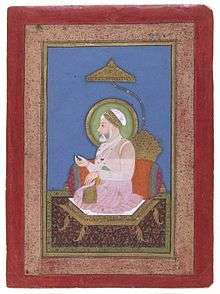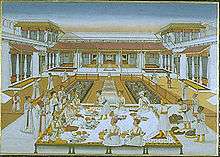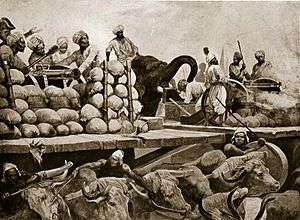Alamgir II
| Alamgir II (Aghrid Yaldosz) | |||||
|---|---|---|---|---|---|
| Mughal Emperor | |||||
 | |||||
| 14th Mughal Emperor | |||||
| Reign | 2 June 1754 – 29 November 1759 | ||||
| Predecessor | Ahmad Shah Bahadur | ||||
| Successor | Shah Jahan III | ||||
| Regent |
Imad-ul-Mulk (1754–1756) Najib-ul-Daula (1756–1759) Imad-ul-Mulk (1759) | ||||
| Born |
6 June 1699 Multan, Mughal Empire | ||||
| Died |
29 November 1759 (aged 60) Kotla Fateh Shah, Mughal Empire | ||||
| Burial | Humayun's Tomb | ||||
| Spouse |
Sayyid Begum Zinat Mahal Faiz Bakht Begum Azizabadi Mahal Latifa Begum Zinat Afraz Begum Aurangabadi Mahal | ||||
| Issue |
Mirza Abdullah Ali Gouhar a.k.a. Shah Alam II Mirza Muhammad Ali Asghar Bahadur Mirza Muhammad Harun Hidayat Bakhsh Bahadur Mirza Tali Murad Shah Bahadur Mirza Jamiyat Shah Bahadur Mirza Muhammad Himmat Shah Bahadur Mirza Ahsan-ud-Din Muhammad Bahadur Mirza Mubarak Shah Bahadur 12 daughters including: < Zuhra Begum | ||||
| |||||
| Dynasty | mughal empire | ||||
| Father | Jahandar Shah | ||||
| Mother | Saira Begum | ||||
| Religion | Islam | ||||
Aziz-ud-din Alamgir II (6 June 1699 – 29 November 1759), (عالمگير ثانی) was the Mughal Emperor of India from 3 June 1754 to 29 November 1759. He was the son of Jahandar Shah.
Aziz-ud-Din, the second son of Jahandar Shah, was raised to the throne by Imad-ul-Mulk after he deposed Ahmad Shah Bahadur in 1754. On ascending the throne, he took the title of Alamgir and tried to follow the approach of Aurangzeb Alamgir. At the time of his accession to throne he was an old man of 55 years. He had no experience of administration and warfare as he had spent most of his life in jail. He was a weak ruler, with all powers vested in the hand of his vizier, Ghazi-ud-Din Imad-ul-Mulk.
In 1756, Ahmad Shah Abdali invaded India once again and captured Delhi and plundered Mathura. Marathas became more powerful because of their collaboration with Imad-ul-Mulk, and dominated the whole of northern India. This was the peak of Maratha expansion, which caused great trouble for the Mughal Empire, already weak with no strong ruler. Relations between Alamgir II and his usurping vizier, Imad-ul-Mulk had now deteriorated. He was murdered by Imad-ul-Mulk. Alamgir II's son Ali Gauhar escaped persecution from Delhi, while Shah Jahan III was placed on the throne.
Early life
He was born on 6 June 1699 at Multan and was the second son of Maaz-ud-Din, the son of future Emperor Bahadur Shah I. Alamgir II was 7 when his great-grandfather Aurangzeb died in the Deccan during a campaign fighting the Marathas. He married his cousin, Princess Sayyid Banu Begum, the daughter of his uncle, Rafi-ush-Shan, on 8 April 1712.
After the death of his grandfather, Bahadur Shah I, and the war of succession that followed, his father, Maaz-ud-Din, was defeated, by the next Mughal Emperor, Farrukhsiyar. Aziz-ud-Din was then imprisoned in 1714 and released in 1754, by usurping Vizier Imad-ul-Mulk, he perceived Aziz-ud-Din as a frail personality who would not object his regime. Therefore, on 2 June 1754, Aziz-ud-Din was given the title Alamgir II by the vizier out of his own recommendation, as he wanted to follow the centralised approach of Aurangzeb.
Succession to throne

Imad-ul-Mulk was clearly a man of no principles and was commonly criticised for his extreme selfishness. he hired Maratha mercenaries to do his bidding[1] and put all the imperial revenues into his own pocket and starved Alamgir II's family. He persecuted Ali Gauhar, the elder son of Alamgir II.
Since then, relations between Alamgir II and Imad-ul-Mulk's regime were so bad that the latter got him assassinated in November 1759.
Reign
After the emergence of Alamgir II the Mughal Empire had impulsively began to re-centralize, particularly when many Nawabs sought the gratification of the Mughal Emperor and his co-ordination regarding their resistance to the Maratha. This development was clearly unwelcome by Imad-ul-Mulk who sought to strengthen his authoritarianism with the undaunted support of the Marathas.
Alliance with the Durrani Emirate
In the year 1755, the acclaimed Mughal viceroy of Punjab, Muin ul-Mulk died his widow Mughlam Begum desperately sought the assistance of Ahmad Shah Durrani to halt any succession struggle and to quell the Sikh rebels in the eastern regions.
Ahmad Shah Durrani and his forces then marched into Lahore in the year 1756 and appointed his son Timur Shah Durrani as the new viceroy at Lahore, under the protection of the commander Jahan Khan and also placed Adina Beg as the Faujdar of Doab. Ahmad Shah Durrani then plundered Sikh and Hindu inhabitants in the unstable and outlawed eastern regions of the Punjab.
He then marched towards Delhi, in October 1757, the Mughal Emperor Alamgir II with courtiers such as Shah Waliullah, nobles such as Najib-ul-Daula, and the imperial family went to meet Ahmad Shah Durrani, whose forces then engaged the Marathas in combat and threatened to overthrow and execute the regime of Imad-ul-Mulk.
Ahmad Shah Durrani's relations with the Mughal Emperor, strengthened further when his son Timur Shah Durrani was chosen as the suitor of Alamgir II's daughter Zuhra Begum. Ahmad Shah Durrani himself also married Hadrat Begum the daughter of the former Mughal Emperor Muhammad Shah.
Durrani's harry the Punjab
Ahmad Shah Durrani returned to Kabul leaving his forces led by his son Timur Shah Durrani consolidating themselves inside the garrisons of Lahore where they founded the Zamzama cannon with the assistance of Mughal Metalsmiths. He was supported by Mohammad Bahawal Khan II (Nawab Amir of Bhawalpur) and Muhammad Nasir Khan I (Khanate of Kalat).[2]
-

Alamgir II became an ally of Ahmad Shah Durrani in the year 1757.
-

Timur Shah Durrani was the son-in-law of the Mughal Emperor Alamgir II and the brother-in-law of Shah Alam II.
Siege of Delhi (1757)

In July 1757, the Maratha's led by Raghunathrao rejected the matrimonial alliance established between the Durrani Empire and the Mughal Empire, they were assisted by Imad-ul-Mulk and encamped 30 km opposite to the Red Fort and occupied all the villages by the Jamuna. And thus began to stage the Siege of Delhi (1757), against the incumbent administration of the Alamgir II's, Mir Bakshi ("Paymaster of the Mughal Empire") Najib-ul-Daula along with his lieutenants Qutub Shah and Aman Khan and a Mughal Army of 2,500 garrisoned inside the metropolis of Delhi. The Maratha set ferries ablaze and stopped food supplies from entering Delhi, while Najib-ul-Daula positioned his heavy artillery outside the vicinity of the Red Fort. Unable to gain any assistance form Ahmad Shah Durrani, who was engaged in quelling various rebellions near Herat; Najib-ul-Daula surrendered after resisting the combined brigands of Maratha Confederacy for more than five months, he conceded defeat and withdrew to Najibabad. Imad-ul-Mulk abolished Alamgir II's incumbent administration and with the support of the Marathas was reappointed Mir Bakshi and thenceforth began a scrimmage to persecute the Mughal imperial family.[3]
Subjects opposing the Maratha Confederacy
However, despite losing control of Delhi, Najib-ul-Daula and his associates, such as Qutub Khan and Abdus Samad Khan the Mughal Faujdar of Sirhind, continued to challenge the Maratha Confederacy and its allies during confrontations at Saharanpur and Shahabad Markanda. In response the Marathas sacked the inhabitants of Taraori, Karnal and Kunjpura.[3]
In the year 1756, Alamgir II sympathised with the cause of his loyal Nawabs of Kurnool, Cuddapah and Savanur, when their assigned territories were ravaged and plundered until 1757 by the Maratha chieftain Balaji Baji Rao.

Third Carnatic War (1757–1763)
Loss of Bengal
Alamgir II grieved the death of Alivardi Khan the famous Nawab of Bengal, who annually pledged 5 million dams to the imperial court. His successor Siraj-ud-Daula was recognised as the next Nawab of Bengal, but he faced internal rivals who refused to consider the Firman granted by Alamgir II to Siraj-ud-Daula. These internal conflicts would lead Siraj-ud-Daula to hastily annex Calcutta from the English East India Company, without the permission of the Mughal Emperor Alamgir II and Salabat Jung. Siraj-ud-Daula was quickly defeated by Clive who recaptured Calcutta and defeated Siraj-ud-Daula during the Battle of Plassey in the year 1757. After the annihilation of his entire army Siraj-ud-Daula fled and was killed by the forces of the treacherous Mir Jafar. The deceased Siraj-ud-Daula's pretensions were criticised in the Mughal imperial court by Ghulam Husain Tabatabai, and Alamgir II refused to recognise Mir Jafar as the next Nawab of Bengal. In response to the imperial court's decision Mir Jafar thus consolidated and alliance with the manipulative Imad-ul-Mulk against he imperial family.
Authority in the Deccan
Throughout Alamgir II's reign French commandant de Bussy and Lally and their allies such as Salabat Jung and Hyder Ali greatly contributed to the advancement of forces in the Deccan opposed to the utter dominance of the Maratha renegades, their achievements had earned them fame throughout the influential circles within the Mughal Empire. In the year 1756, Salabat Jung's forces utilised heavy muskets known as Catyocks, which were attached to the ground, it was known to have fired more rapidly than a cannon.[4] These new weapons would completely reverse fortunes of the Maratha rebels. Soon after the Battle of Plassey, the French commander De Bussy, also entitled Saif-ud-Daula Umdat-ul-Mulk and Mansabdar of 7000, by the Mughal Emperor Alamgir II. He captured the Northern Circars from the British along with his assistant Hyder Jung the "Vakil" (attorney) representing the French within the Mughal Empire and Salabat Jung. However the Northern Circars were retaken by Forde in the year 1758 and De Bussy was recalled to France. Fearing the worst Salabat Jung reconciled with the English East India Company and recognised their protectorate and was soon overthrown by his own brother Nizam Ali Khan.
Nawab of Bhopal
In the year 1758, the Mughal Army of Faiz Mohammad Khan the Nawab of Bhopal was treacherously attacked by his step-mother Mamola Bai who suddenly besieged the Mughal garrison at Fortress of Raisen in 1758, according to the layout of the Marathas. The outraged Mughal Emperor Alamgir II, then issued a Firman supporting Faiz Mohammad Khan was the Nawab of Bhopal the only chosen administrator of Raisen, the emperor also granted the title Bahadur to Faiz Mohammad Khan the Nawab of Bhopal. However the fort remained under the control of Mamola Bai and the renegade Nanasaheb Peshwa.. The fortress of Raisen was quickly retaken by Faiz Mohammad Khan in the year 1760, after the tragic assassination of Alamgir II and after Sadashivrao Bhau threatened to ravage Bhopal prior to the Third Battle of Panipat. It is believed that Faiz Mohammad Khan's Mughal troopers were among those who had cut off the various supply routes of the Marathas just before the Third Battle of Panipat.
Zenith of the Maratha Confederacy
In 1758 the Marathas led by Raghunathrao occupied Lahore after extracted an extortion of imperial wealth from Imad-ul-Mulk, together they conspired the overthrow of young Timur Shah Durrani. Raghunathrao drove out Jahan Khan and Timur Shah Durrani, the son and viceroy of Ahmad Shah Durrani. Timur Shah Durrani and his forces were forced to retreat from Lahore to Peshawar under the force of attacks from Sikhs and Marathas. This victory made the belligerent Peshwa, grandiosely sack Delhi and hype their intentions of placing Vishwasrao on the Mughal throne.[5]
Assassination
Suddenly in the summer of the year 1759 Prince Ali Gauhar escaped from Delhi. Agitated by the daring escape Imad-ul-Mulk and Sadashivrao Bhau reckoned that Alamgir II was about to advance his son Prince Ali Gauhar, to dispossess and overthrow their authority. After detailed consideration Imad-ul-Mulk and Sadashivrao Bhau plotted to murder the Mughal Emperor Alamgir II and the assassinations of prominent members of his family in the winter of 1759.[6]
Aftermath
Sadashivrao Bhau then personally chose the usurping, Shah Jahan III as the new Mughal Emperor and began a campaign of plundering the Jewels and ornaments of the Mughal imperial court, he also defaced mosques, tombs and shrines that the Mughals had built in Agra and Delhi, he then desecrated the imperial Moti Masjid and looted its exquisite jewelled decorations into booty for the ravaging Marathas.[7]
The defeat of Alamgir II's son-in-law, Timur Shah Durrani by the Marathas in the year 1760, provoked the wrath of Ahmad Shah Durrani, who launched a massive campaign gathering more troops than ever before. In response to the atrocious crimes committed by Imad-ul-Mulk and Sadashivrao Bhau; Najib-ud-Daula and his firm alliance of principal Muslim nobles in the Mughal Empire recaptured Delhi and placed it under the nominal authority of Shah Alam II. In the south Hyder Ali and his Mysore Army ferociously attacked the Maratha. Meanwhile, Shah Alam II anticipated the collapse of the Maratha and declared Shuja-ud-Daula his Grand Vizier and Najib-ud-Daula as his honorary Mukhtar Khas (Chief Representative).[8][9] These developments eventually culminated into rise of relegious and political loyalties that eventually clashed at the "Third Battle of Panipat" in the year 1761.
Foreign relations

In 1755, De Bussy received letter from new Mughal Emperor Alamgir II requesting French assistance to put down the Maratha Confederacy. Alamgir II asked if it was possible for De Bussy to dispatch a French contingent of 1000 strong to protect the Mughal Empire's capitol at Delhi. Alamgir II also promised to pay a hefty sum for the maintenance of the French and even promised to settle disputes in the Carnatic Wars in favour of the French East India Company.[10]
In 1757, Alamgir II had successfully achieved peace between the Durrani Emirate and the Mughal Empire. Alamgir II even secured a matrimonial alliance[11] when Timur Shah Durrani married Gauhar Afroz Begam the daughter of the Mughal Emperor Alamgir II in February 1757 and Ahmad Shah Durrani married Hazrat Begum the daughter of the former Mughal Emperor Muhammad Shah in 1757.[12]
Death
The newly appointed Mughal Grand Vizier after Ahmad Shah Durrani's invasion was Najib-ud-Daula who consolidated the remains of the Mughal Empire by uniting distant Faujdars, Nawab's and Nizams into a common cause against the Marathas.
Fearing their wrath the deposed Imad-ul-Mulk consolidated himself with the Maratha leader Sadashivrao Bhau and launched an attack which lasted 15 days and caused the defeat of Najib-ud-Daula and drove North. Imad-ul-Mulk then feared that the Mughal Emperor Alamgir II would recall Ahmad Shah Durrani, or use his son Prince Ali Gauhar, to dispossess him of his newfound power with the Marathas.
Therefore, Imad-ul-Mulk plotted to murder the Mughal Emperor Alamgir II and his family. A few Mughal Princes, including Ali Gauhar desperately managed to escape before assassination. In November 1759, the Mughal Emperor Alamgir II was told that a pious man had come to meet him, Alamgir II, ever so eager to meet holy men, set out immediately to meet him at Kotla Fateh Shah, he was stabbed repeatedly by Imad-ul-Mulk's assassins. The Mughal Emperor Alamgir II's death was mourned throughout the Mughal Empire, particularly by the Muslim populace, who soon organised the Third Battle of Panipat, which avenged the death of Alamgir II and enthroned his bold son Shah Alam II in the year 1761.
After the assassination of Alamgir II in 1759, the Peshwa under the sway of Sadashivrao Bhau had reached the peak of its short-lived power particularly when their involvement in the assassination had become eminent when he discussed abolishing the Mughal Empire and placing Vishwasrao on the throne in Delhi by bribing or deposing Imad-ul-Mulk.[5]
Traits
Alamgir II was, by birth, a pious man. He never missed any prayer in the imperial Pearl Mosque and occasionally delivered the sermons as well, he was a friend and patron of Sufi mystics, he is also known to have walked through the streets of Delhi to attend prayers at different Mosques without adequate security.
See also
References
- ↑ http://www.emotional-literacy-education.com/classic-books-online-a/tfmeh10.htm
- ↑ http://thebaluch.com/documents/Nasir%20Khan%20Noori.pdf
- 1 2 Jaswant Lal Mehta. Advanced Study in the History of Modern India 1707–1813. Retrieved 2014-01-31.
- ↑ Kaushik Roy (2011-03-30). War, Culture and Society in Early Modern South Asia, 1740-1849. Retrieved 2014-01-31.
- 1 2 Elphinstone, Mountstuart (1841). History of India. John Murray, Albermarle Street. p. 276.
- ↑ "Alamgir II (Mughal emperor) - Encyclopedia Britannica". Britannica.com. 2012-11-21. Retrieved 2014-01-31.
- ↑ Shaharyar M. Khan (2000-10-20). The Begums of Bhopal: A History of the Princely State of Bhopal. Retrieved 2014-01-31.
- ↑ Raghunath Rai. History. Retrieved 2014-01-31.
- ↑ Hermann Kulke, Dietmar Rothermund. A History of India. Retrieved 2014-01-31.
- ↑ Sarojini Regani. Nizam-British Relations, 1724–1857. Retrieved 2014-01-31.
- ↑ S.R. Sharma. Mughal Empire in India: A Systematic Study Including Source Material. Retrieved 2014-01-31.
- ↑ Students' Britannica India. Retrieved 2014-01-31.
External links
![]() Media related to Alamgir II at Wikimedia Commons
Media related to Alamgir II at Wikimedia Commons
| Alamgir II | ||
| Preceded by Ahmad Shah Bahadur |
Mughal Emperor 2 June 1754– 29 November 1759 |
Succeeded by Shah Alam II |